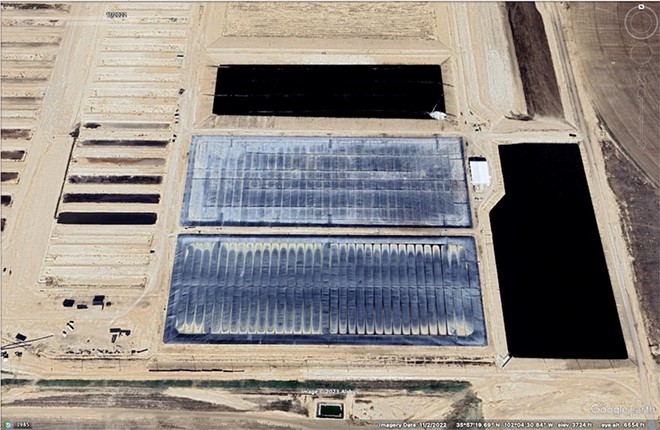
Google Earth
Coated manure lagoons or dairy digesters seize methane emissions as cow manure decomposes. The black plastic tarps on the North Dumas Farms look like accumulating biogas as of November, 2022, nevertheless it stays unclear if the fuel is being flared or injected right into a fuel pipeline to be used as gas. Credit score: Google Earth
This text initially appeared on Inside Local weather Information, a nonprofit, impartial information group that covers local weather, power and the atmosphere. It’s republished with permission. Join their e-newsletter right here.
Three years in the past, North Dumas Farms was an empty discipline close to the northern fringe of the Texas Panhandle. As we speak it’s a huge dairy operation—and one of many largest greenhouse fuel emitters within the state.
The dairy is permitted to carry as much as 72,500 cows, whose burps and manure would produce an estimated 13,096 metric tons of methane annually, in response to an Inside Local weather Information evaluation of knowledge from the Texas Fee on Environmental High quality.
This evaluation builds on the pioneering work of Local weather TRACE, a nonprofit coalition that’s growing strategies to offer a farm-by-farm stock of methane emissions from cattle primarily based on public information, satellite tv for pc imagery and synthetic intelligence.
Methane is a potent greenhouse fuel that on a pound for pound foundation is 81 instances more practical at warming the earth’s environment than carbon dioxide over a 20-year interval. If all the methane produced by the North Dumas dairy entered the environment, the farm’s annual greenhouse fuel emissions would equal that of almost a quarter-million vehicles.
Methane’s efficiency as a greenhouse fuel mixed with its quick lifetime—methane stays within the environment for simply 12 years—implies that curbing emission of the fuel is the only greatest option to fight local weather change within the quick time period, in response to the United Nations’ Intergovernmental Panel on Local weather Change, or IPCC.
Nationwide, cows collectively emitted greater than twice as a lot methane from their burps and manure as all oil and fuel wells mixed, together with these lively or deserted, onshore or offshore, in 2020, in response to an Inside Local weather Information assessmentof knowledge within the Environmental Safety Company’s 2022 Stock of U.S. Greenhouse Gasoline Emissions.
However you gained’t discover North Dumas Farms, or some other American dairy or livestock operation, in any authorities greenhouse fuel database.
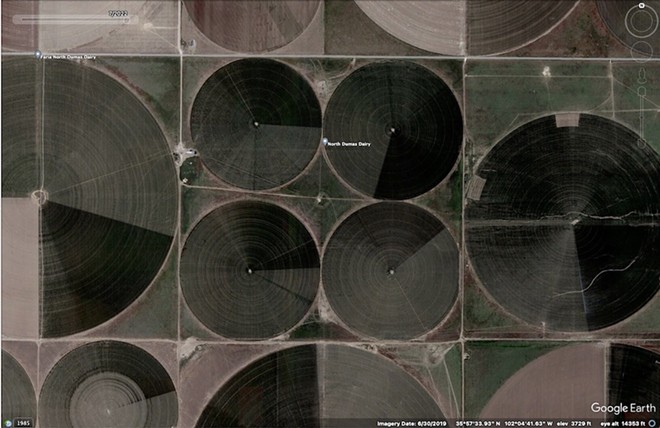
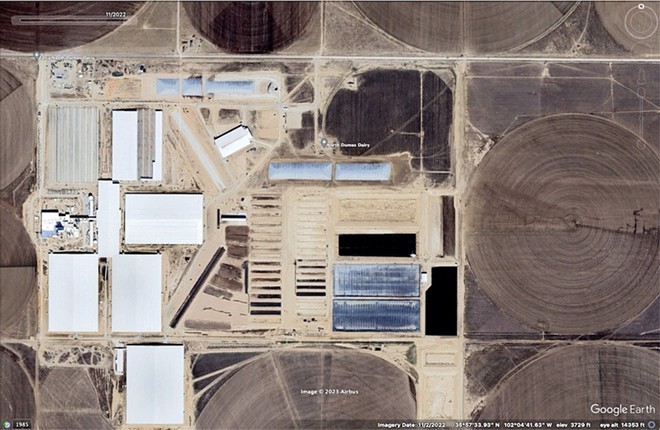
Google Earth
4 years in the past the North Dumas Farms was an empty farm discipline, as proven within the photograph on the left, which was made on June 30, 2019. As we speak, it is without doubt one of the largest dairies in Texas, permitted to carry as much as 72,500 cows. The photograph on the precise reveals the dairy on November 2, 2022.
The EPA’s Greenhouse Gasoline Reporting Program, which was established in 2007 to offer detailed accounting, facility by facility, on emissions from “all sectors of the U.S. economic system,” exempts agriculture.
And the Texas Level Supply Emissions Stock, an annual state survey of enormous, industrial polluters, excludes greenhouse gasesaltogether. In a state more and more threatened by droughts, warmth waves, and extra frequent and intense storms linked to local weather change, there’s little details about methane from cattle.
Whereas higher often called a beef-producing state, with almost twice the variety of beef cattle as some other state, Texas has quickly expanded its dairy manufacturing in latest many years. As we speak it’s the nation’s third-largest dairy producer, and in north Texas, the place the state trade is concentrated, the variety of dairy cows elevated “by a whopping 3,500% from 1995 to 2015,” in response to a latest report by the Texas Home Committee on Agriculture & Livestock. Which means there have been 36 instances as many cows within the area in 2015 as there have been 20 years earlier.
This presents a monumental downside because the nation begins mustering the resolve to rein in local weather change. “If we’re going to realize net-zero [emissions], we’ve got to be addressing all our gases, from all our sources,” stated Katharine Hayhoe, an atmospheric scientist at Texas Tech College and the chief scientist for the Nature Conservancy, referring to the Biden administration’s goal for 2050. “We now have to know the place all our emissions are coming from.”
The EPA excluded methane emissions from cows when it launched its greenhouse fuel reporting program in 2009, stating that “the methodologies are unsure, variable and burdensome for reporters.”
For many years, environmental advocacy organizations have submitted public information requests and filed lawsuits towards the EPA in a quest for this knowledge however have been thwarted in compiling even fundamental info on the situation and measurement of enormous industrial farms in most states.
That is the void that Local weather TRACE, a coalition of organizations co-founded by former Vice President Al Gore, is looking for to fill.
“We should always be capable to know the place these amenities are,” stated Sam Schiller, who led the agriculture work for Local weather TRACE and is chief govt of Carbon Yield, an organization that helps farmers entry income streams that reward them for decreasing their greenhouse fuel emissions. “You possibly can’t handle what you don’t measure.”
Zeroing in on Texas and California
Schiller and his colleagues first centered on Texas and California, the place state wastewater permits doc the quantity and kind of cows allowed or at the moment housed at every dairy or livestock operation. Then they utilized estimates developed by the IPCC for the amount of methane launched by particular person dairy or beef cows to calculate every facility’s annual methane emissions.
The group is now coaching synthetic intelligence to determine cattle manufacturing amenities worldwide primarily based on satellite tv for pc photos. They’ve additionally constructed fashions that relate cattle numbers from wastewater permits to satellite tv for pc photos displaying every facility. As soon as educated, the AI system and modeling effort ought to be capable to estimate the variety of cows from satellite tv for pc photos of cattle-feeding operations in locations that lack dependable allowing knowledge, Schiller stated.
“Our work with Local weather TRACE actually is about constructing higher knowledge techniques that monitor the progress, or lack of progress, in agriculture and actually assist put into the general public area the type of instruments that that you must monitor emissions from agriculture,” Schiller stated.
Inside Local weather Information generated an interactive map of methane emissions from dairies and cattle feedlots throughout Texas by drawing on up to date state wastewater permits that weren’t accessible to Local weather TRACE on the time of its evaluation final yr.
TK
Rob Jackson, an earth system science professor at Stanford College who is just not affiliated with Local weather TRACE, stated that farm-by-farm knowledge is essential for decreasing emissions.
“It offers us energy to trace air pollution,” Jackson stated. “We wish to have the ability to have a lookup desk for each massive greenhouse gas-emitting supply on this planet. The place is it? Who owes it? How a lot are they emitting? And the way a lot have they reduce emissions?”
Daniel Lee Miller, a lecturing fellow in environmental regulation at Duke Regulation College, agreed.
“If the regulators should not going to do their job in producing an correct rely of those amenities and making an correct evaluation of their contributions to local weather change, then I’m delighted that others are stepping in to fill that hole,” he stated.
Tax the cow burps, environmentalists plead
The rising curiosity in pinpointing the sources of methane emissions comes as environmentalists name on Gov. Greg Abbott of Texas to place a worth on methane emissions from cows.
The Physicians Committee for Accountable Drugs, a nonprofit group primarily based in Washington, D.C., that promotes a plant-based weight loss plan, not too long ago positioned billboards on the outskirts of two Texas Panhandle cities, together with Hereford, the self-proclaimed “beef capital of the world,” calling on Abbott to “tax cow burps.”
“What’s good for the atmosphere can also be good for our well being,” stated Anna Herby, the vitamin training program supervisor for the Physicians Committee. In a letter to the governor, the group urged him to make use of the tax income to assist the planting of “climate-friendly crops” which might be excessive in protein, develop nicely within the area and have a far-lower carbon footprint, like drought-tolerant beans.
The governor’s workplace didn’t reply to a request for remark concerning the letter.
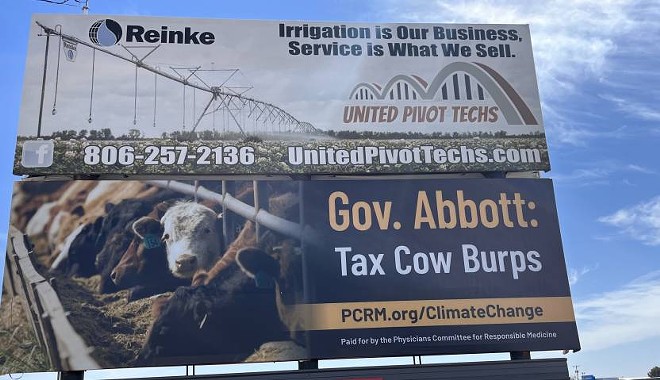
Courtesy Picture / Physicians Committee for Accountable Drugs
A billboard that went up in April, 2023 in Littlefield, Texas referred to as on governor Greg Abbott to “tax cow burps.” The billboard was paid for by the Physicians Committee for Accountable Drugs.
Darren Turley, the manager director of the Texas Affiliation of Dairymen, advised that such a tax proposal can be a nonstarter within the state. “Proper now in Texas, we haven’t actually had the urge for food to go down that path,” he stated.
Hayhoe, the atmospheric scientist at Texas Tech, lamented the physicians group’s technique, saying the billboards ship the improper message to farmers.
The billboards are “demonizing their lifestyle,” she stated. “My guess, primarily based on the results of these billboards, there can be extra massive cattle producers who’re actively conscious of and against efforts to tax emissions from dairy and beef cattle now than they had been earlier than.”
Hayhoe means that local weather advocates would have higher success in the event that they first acknowledged the nice that farmers do in offering meals for the remainder of society and serving pretty much as good stewards of their land. Then, she stated, they might see if there have been methods they might work with cattle farmers to handle local weather change.
One space the place the 2 teams could discover widespread floor is biogas digesters, which seize methane from cow manure because it breaks down. A number of of the most important dairies in Texas have not too long ago put in digesters or are within the means of doing so. The methane they produce could also be eligible for incentives underneath California’s Low Carbon Gas Customary, Turley stated. California awards Low Carbon Gas Customary credit to producers of low-carbon fuels together with biogas from cows. The gas doesn’t need to be produced in California.
Don Devries, the proprietor of Morning Star Dairies, one of many largest dairies in Texas, stated he was at the moment working with a developer to put in a biogas digester that’s anticipated to slash his operation’s methane emissions.
“I feel it’s a win-win for everyone, and the atmosphere,” Devries stated.
An explosion of industrialized farming
The knowledge on dairies and feedlots unearthed by Local weather TRACE makes an attempt to fill a niche in knowledge that has persevered for many years as federal and state regulators did not precisely assess the local weather impression of the livestock trade. At the same time as the information went unreported, the sprawling industrial livestock operations often called Concentrated Animal Feeding Operations, or CAFOs, had been multiplying throughout the nation, churning out huge quantities of manure together with meat and milk.
“EPA doesn’t know the place these CAFOs are and has not put the sources in to examine and determine these CAFOs and maintain them accountable,” stated Emily Miller, an legal professional with Meals & Water Watch, a nonprofit watchdog group that has pressed the company by way of lawsuits and petitions to strengthen its regulatory oversight. “If we did have extra info on the place CAFOs had been within the nation and the way they function and what number of animals they’ve, it could definitely be simpler to calculate their methane emissions.”
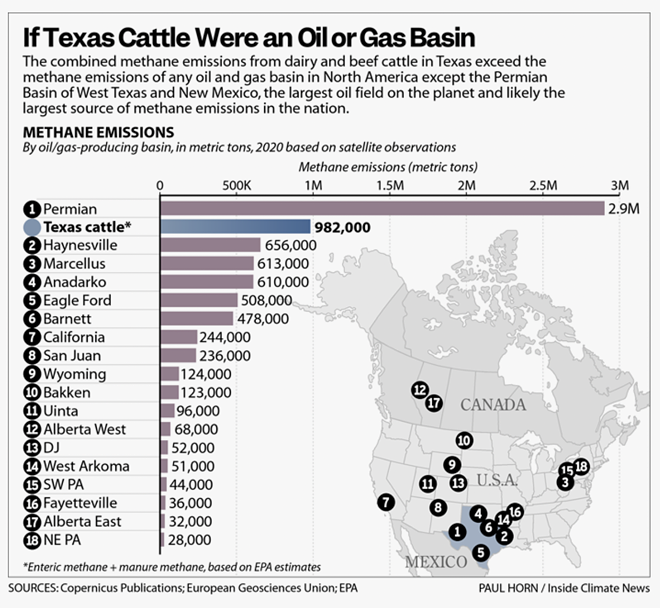
Along with methane emissions, the manure produced by carefully confined animals on massive industrial farms contributes to nutrient air pollution by way of runoff to creeks, rivers and lakes, which is why federal and state wastewater laws exist.
A 2008 report by the U.S. Authorities Accountability Workplace, a nonpartisan congressional company, concluded that the EPA couldn’t fulfill its obligation to watch CAFO air pollution till it obtained correct “facility-specific” details about CAFOs and their places.
The company acknowledged that it had no correct nationwide stock of CAFOs, and stated it could work with states to introduce a nationwide knowledge system that supplied an correct tally. At present, solely one-third of the nation’s 21,000 largest CAFOs have wastewater permits.
The EPA adopted up by proposing laws that might require CAFOs to acquire wastewater permits, however the trade challenged the principles in courtroom and gained. Finally, the environmental teams and the company agreed to a settlement with the livestock trade, requiring the EPA to suggest yet one more rule. This one, issued in 2011, would have required CAFOs to submit fundamental details about their operations and amenities to the company.
However the next yr, the company withdrew the rule, saying it might receive the data it wanted from states and different sources with out it—one thing it had beforehand deemed unattainable—and that it could work with states to take action.
Environmental teams filed Freedom of Info Act requests to the EPA in 2012 to see whether or not the company was following by way of. Nonetheless, a lawsuit filed by the American Farm Bureau Federation and the Nationwide Pork Producers Council subsequently blocked the company’s launch of public information.
In 2021, Meals & Water Watch sued EPA, looking for stronger effluent limitation tips for CAFOs. In response, the company introduced earlier this yr that it could undertake an in depth research of CAFO water air pollution to find out whether or not and tips on how to strengthen the rules.
This week, underneath a settlement deadline in a separate Meals & Water Watch-led lawsuit, the company denied a Meals & Water Watch-led 2017 petition looking for to develop and enhance water air pollution allowing. As an alternative, the company stated it could solely type a federal advisory committee to check CAFO air pollution starting in 2024.
The advisory committee will contemplate insufficient allowing, amongst different points raised within the petition, and the EPA says it can complement the detailed research.
If there is a will
Environmental specialists argue that if state and federal regulators had been keen, they might present emissions knowledge just like what Local weather TRACE is now producing for particular person dairies and feedlots.
“They might in fact take these measurements in the event that they needed to,” stated Miller, the Duke Regulation College professor. “To say that we simply actually can’t estimate on the facility stage with any type of certainty—that doesn’t maintain any water for me.”
The EPA at the moment reviews statewide and nationwide estimates of methane emissions from cows with a easy and surprisingly correct technique. The company tallies the variety of cows in a given space after which multiplies that quantity by one among a number of “emissions elements,” the typical methane emissions from a cow over the course of the yr.
The IPCC, which first developed the emissions elements in 2006, assigns completely different figures relying on standards together with whether or not the animal is a dairy or beef cow, the feed it ingests and the local weather circumstances the place it lives.
Whereas the EPA makes use of the emissions elements to estimate the entire methane emissions from cows for the nation and state by state, the company stated the information yielded from this strategy is just too crude to estimate emissions from particular person dairies or feedlots.
Nonetheless, in a research printed within the journal Atmospheric Surroundings in 2022, researchers discovered that the emissions-factor strategy was “in a position to estimate real-world CH4 [methane] emissions” at particular person dairies and “adequately” predicted methane concentrations within the air surrounding the dairies.
Ben Weinheimer, president of the Texas Cattle Feeders Affiliation, an trade group representing livestock homeowners in Texas, Oklahoma and New Mexico, argues that the emissions-factor strategy fails to account for efforts particular person feedlot homeowners would possibly quickly undertake to cut back emissions, like utilizing feed components that cut back methane emissions.
Subscribe to SA Present newsletters.
Comply with us: Apple Information | Google Information | NewsBreak | Reddit | Instagram | Fb | Twitter| Or join our RSS Feed





